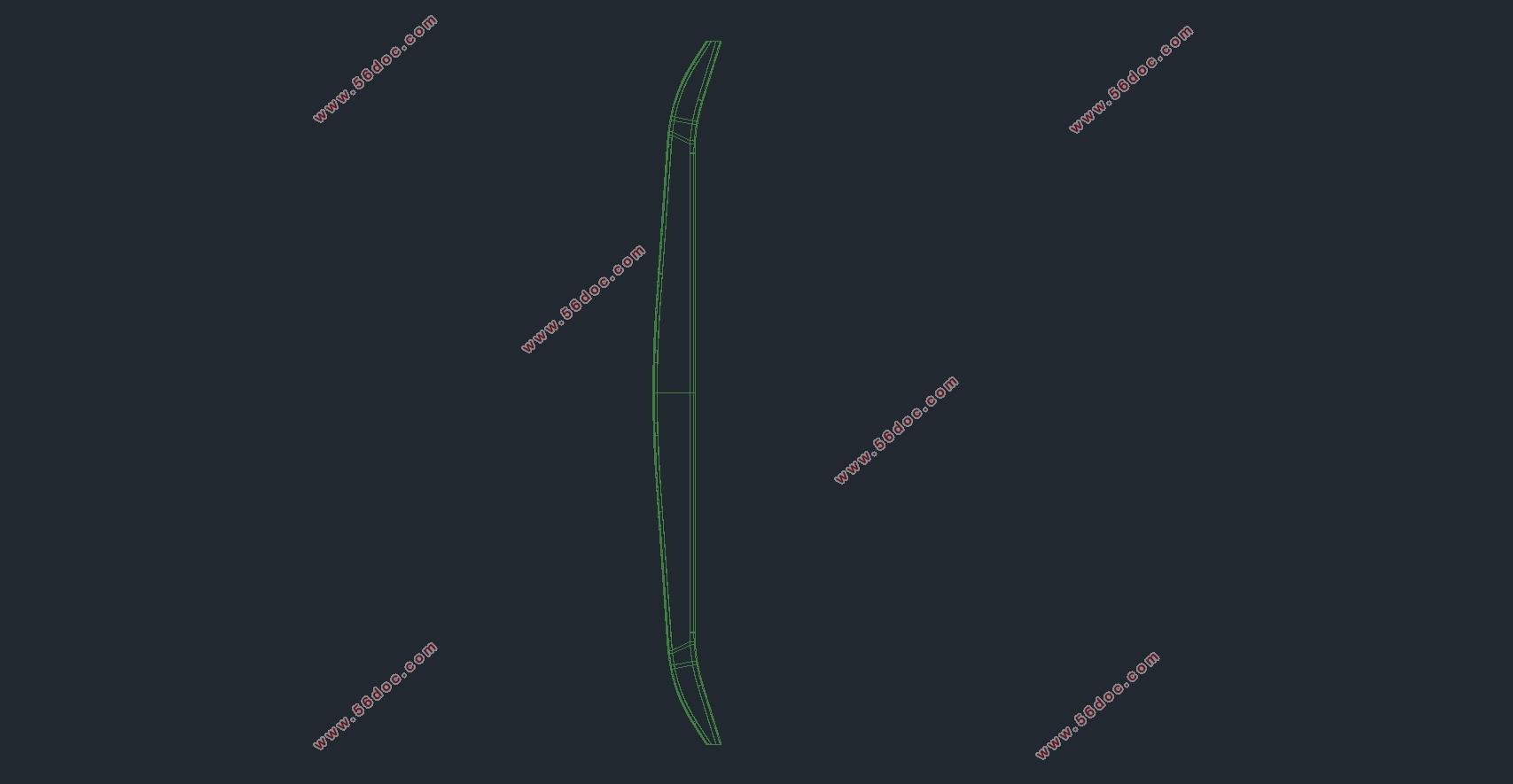碳纤维复合材料汽车防撞梁设计及性能分析(任务书,开题报告,文献摘要,外文翻译,论文说明书24000字,CAD图1张)
摘 要
汽车轻量化和新能源是汽车产业中具有战略意义的两大方向,实现汽车的轻量化,可以减轻汽车各部分的重量,同时有利于改善汽车的动力性、舒适性和操纵稳定性,在汽车部分结构零件中运用复合材料是实现轻量化的一个有效的方法。汽车防撞梁在受到撞击后,减轻车门变形程度,吸收的撞击能量,分散撞击力,从而减少对乘客造成的伤害。碳纤维复合材料则因其比强度高、比模量高、耐高温、抗疲劳强度好、具有可设计等优越性能得到广泛的使用。本文以汽车防撞梁为研究对象,通过材料等代设计碳纤维复合材料防撞梁和高强钢防撞梁的静力强度和低速碰撞强度等性能,主要开展以下研究:
首先,设计防撞梁的结构形式,根据静态分析和低速碰撞的试验方法,划分网格,建立静力载荷和低速碰撞的有限元模型,设定边界条件及加载载荷。
其次,在静止受压、正面碰撞及40%偏置碰撞三种工况下,分别从材料失效、位移变形量及应力大小、系统吸能及比吸能等性能和零件重量方面对高强度钢及碳纤维复合材料防撞梁进行了对比分析。
最后,分析了五种不同铺层形式下CFRP防撞梁在正面碰撞和40%偏置碰撞条件下的变形和失效情况,研究了铺层形式对层合板CFRP防撞梁性能的影响规律。
研究结论表明,碳纤维复合材料的采用一方面能使汽车总质量降低,而另一方面则增加其吸能及比吸能,提升了原结构的各项性能,同时提升了汽车的安全系数。而最佳的铺层设计则减少了碳纤维防撞梁的厚度而提升其安全性能,是研究结果更加具有实际意义。
关键词:轻量化;碳纤维复合材料;高强度钢;防撞梁;铺层设计;静力分析;低速碰撞
Abstract
Lightweight and energy saving are the two strategic direction of the automotive industry, in order to achieve lightweight and improve the car's dynamic performance, comfort and handling stability,using composite material is an effective way to achieve lightweight. After impact, anti-collision beam can reduce the degree of deformation of the door, the impact energy absorption, dispersion impact force, thereby reducing the damage caused to passengers. Carbon fiber composite material is widely used because of high specific strength and specific modulus, high temperature, fatigue strength. In this paper, anti-collision beam uses other material through the static strength generation design carbon fiber composite bumper beams and high-strength steel bumper beam and low-speed impact strength and other properties, mainly in the following research:
First, the structural design of the form of anti-collision beam, according to the static analysis and test methods for low-speed collisions, mesh, static load and establish finite element model of the low-speed collision, setting boundary conditions and loading load.
Secondly, still under pressure, and 40% offset frontal impact crash three kinds of conditions, namely the failure from the material, the size of the displacement and stress deformation, energy absorption systems and specific energy absorption properties and in terms of parts by weight of high strength steel carbon fiber composite material and bumper beams are compared and analyzed.
Finally, the five different forms overlay at 40% offset frontal collision and collision deformation conditions and failure conditions CFRP anti-collision beam to study the influence of ply form laminates of CFRP anti-collision beam performance.
Findings show that the use of carbon fiber composite material which would enable total vehicle mass reduced, while on the other hand to increase its absorption capacity and specific energy absorption, improves the performance of the original structure, while enhancing the safety factor of the car. The optimum mat design is to reduce the thickness of the carbon fiber anti-collision beam and enhance its safety performance, research results more meaningful.
Keywords:Lightweight; overlay design;anti-collision beam; high-strength steel; carbon fiber;static analysis; low-speed collision

目 录
摘 要 I
Abstract II
目 录 I
第1章 绪论 1
1.1 研究背景及意义 1
1.2 汽车轻量化的实现方法 2
1.2.1 结构优化设计 2
1.2.2 先进制造工艺 3
1.2.3 轻量化材料的应用 3
1.3 国内外研究现状 4
1.3.1 汽车碰撞研究现状 4
1.3.2 碳纤维复合材料在汽车上应用的现状 5
1.4 汽车碰撞的研究方法 5
1.5 课题研究方法及内容 6
1.5.1 课题研究的方法 6
1.5.2 课题研究的内容 7
1.6 本文的结构 7
第2章 碰撞仿真有限元基础及复合材料力学基础 8
2.1 引言 8
2.2 碰撞仿真有限元基础理论 8
2.2.1 汽车碰撞的特点 8
2.2.2 非线性有限元理论 8
2.2.3 非线性动态有限元求解控制方程 10
2.3 复合材料力学基础 11
2.3.1 各向异性材料的弹性应力应变关系 12
2.3.2 各向异性材料的耦合效应 12
2.3.3 最大应力强度准则 13
2.4 层合板设计 14
2.5 本章小结 15
第3章 有限元模型的建立及相关指标 16
3.1 引言 16
3.2 防撞梁有限元模型的建立 16
3.2.1 防撞梁结构 16
3.2.2 几何清理及划分网格 16
3.2.3 沙漏控制 18
3.2.4 高强度钢的选用 19
3.2.5 复合材料选用及层合板的设计 19
3.2.6 接触方式 20
3.2.7 连接方式 21
3.2.8 加载载荷及边界条件 21
3.3 防撞梁性能评价指标及失效准则 22
3.3.1 防撞梁性能评价指标 22
3.3.2 失效准则 22
3.4 本章小结 23
第4章 高强度钢与碳纤维复合材料防撞梁性能对比分析 24
4.1 引言 24
4.2 刚度对比分析 24
4.3 正面碰撞对比分析 26
4.3.1 碰撞失效检测 26
4.3.2 碰撞器侵入量对比 27
4.3.3 吸能及比吸能对比 28
4.4 40%偏置正面碰撞对比分析 29
4.4.1 防撞梁材料失效检测 29
4.4.2 碰撞器侵入量对比 30
4.4.3 吸能及比吸能对比分析 31
4.5 本章小结 32
第5章 碳纤维复合材料防撞梁优化设计 33
5.1 引言 33
5.2 碳纤维复合材料铺层分析 33
5.2.1 模型建立 33
5.2.2 静载工况下铺层次序分析 34
5.3 本章小结 36
第6章 总结与展望 37
参考文献 39
致 谢 41
|



